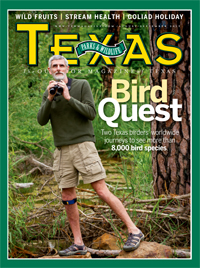
Down by the Riverside
Nature thrives under 20 years of care at Kerrville center.
By Rob McCorkle
In Texas municipalities that have wisely set aside a patch of undeveloped land for native plants and animals, the nature sanctuaries are often established on the edge of the city limits or beyond. Not so in Kerrville, a city of 22,000 that serves as the commercial hub of the Texas Hill Country.
Roughly a half-mile from the heart of downtown, a mama dove sits on her nest in a Mexican plum tree, squadrons of butterflies dive-bomb pollinator plants, couples walk garden paths and children cavort among the trees and rocks at the Riverside Nature Center.
Thanks to a visionary out-of-towner and community support, locals and visitors today can readily access the center, a five-acre former farmstead that belonged to one of the town’s first doctors, ideally situated at the confluence of the Guadalupe River and Town Creek. Easy to find, the center at 150 Francisco Lemos St. is located within the Main Street Historic District.

A renovated visitors center reopened earlier this year.
The current location, however, wasn’t Riverside Nature Center Association founder Susan Sander’s first choice. Not long after she relocated in the early 1980s from Illinois, where she earned a master’s degree in environmental land use planning, Sander spotted a choice wildflower-filled tract on Water Street downtown she felt would be ideal. The land cost proved prohibitive, but Sander would not be deterred.
“When I first started going around talking about the idea of a nature center, people would ask me, ‘What’s a nature center?’” she says, laughing. “We really had to start with educating people about the importance of preserving native landscapes. It evolved from there.”
Sander’s focus shifted to the Town Creek site, and through fundraisers, donations and membership dues, the association raised enough money to purchase in 1992 the first two parcels of mostly open, flat land that sported only a few mature trees. Since then, the association has purchased additional lots and leased City of Kerrville property and easements that provide river and creek access to expand the nature center.
Initially, Sander and a cadre of volunteers, upon whom the center still depends to tend the gardens and conduct educational programs, set about planting more than 100 native trees in what would become the arboretum, using Texas Forest Service grants. Eagle Scouts and other volunteers constructed wood chip and granite trails, and the center was awarded $25,000 toward constructing a covered pavilion. Today, the spacious pavilion is sandwiched between the town’s early 1900s Lawson Store that was moved onto the site and a nature study lab.
A stroll through the 1.5-acre garden area today reveals what 20 years of nurturing and growth can mean to what was once a blank natural canvas. Towering red oaks, pecans and other native trees share the acreage with wildflowers, native grasses and dozens of species of Texas shrubs, cacti and succulents.
The arboretum and onsite rainwater collection exhibits serve to demonstrate to the public how a small tract of land overrun with exotic species can be restored as a showcase for native flora that attract a host of beneficial insects and other critters. Surveys have documented more than 80 butterfly species, 150-plus bird species, more than 140 tree species and more than a dozen different amphibians, reptiles and mammals.
“It helps if people understand where they live,” Sander says of the center. “One of our primary goals is to foster stewardship through education and showcase what can be done by Hill Country landowners to establish native habitat and conserve water and other natural resources. My personal goal: I want citizens to be ecologically literate.” The nature center allows visitors to view at least one specimen of a number of different tree and plant species that are endemic to the Edwards Plateau or are Hill Country natives rarely seen on public lands. They include an anacacho orchid tree, sycamore-leaf snowbell, sabal palm, Mexican pinyon pine, Texas madrone, smoke tree and Blanco crabapple. And, visitors will find a few interesting species that are non-natives, such as the ginkgo tree, a species dating to the time of dinosaurs.
In 1999, the 10th anniversary of the organization’s founding, a 5,400-square-foot visitors center opened, providing ample office and classroom space. A newly renovated visitors center reopened earlier this year with the addition of seasonal exhibit space, a children’s nature niche and a small museum combining traditional exhibits with modern technology.

Nature and conservation are on display at the Riverside Nature Center.
Future plans, according to the center’s executive director, Mary Muse, include the creation of interactive QR codes for signs and interpretive exhibits that visitors can scan with smartphones to glean more information on such topics as the Guadalupe River, the importance of watersheds and native flora and fauna. In addition, the center is developing a Texas Wildscapes demonstration area for people using the recently opened River Trail, whose first official trailhead is located at the Riverside Nature Center.
The center is open 9 a.m. to 4 p.m. on weekdays and 10 a.m. to 3 p.m. on weekends. The garden area, however, can be toured from dawn until dusk seven days a week. For more information, visit www.riversidenaturecenter.org.
Related stories
Kerrville: Heart of the Hill Country

